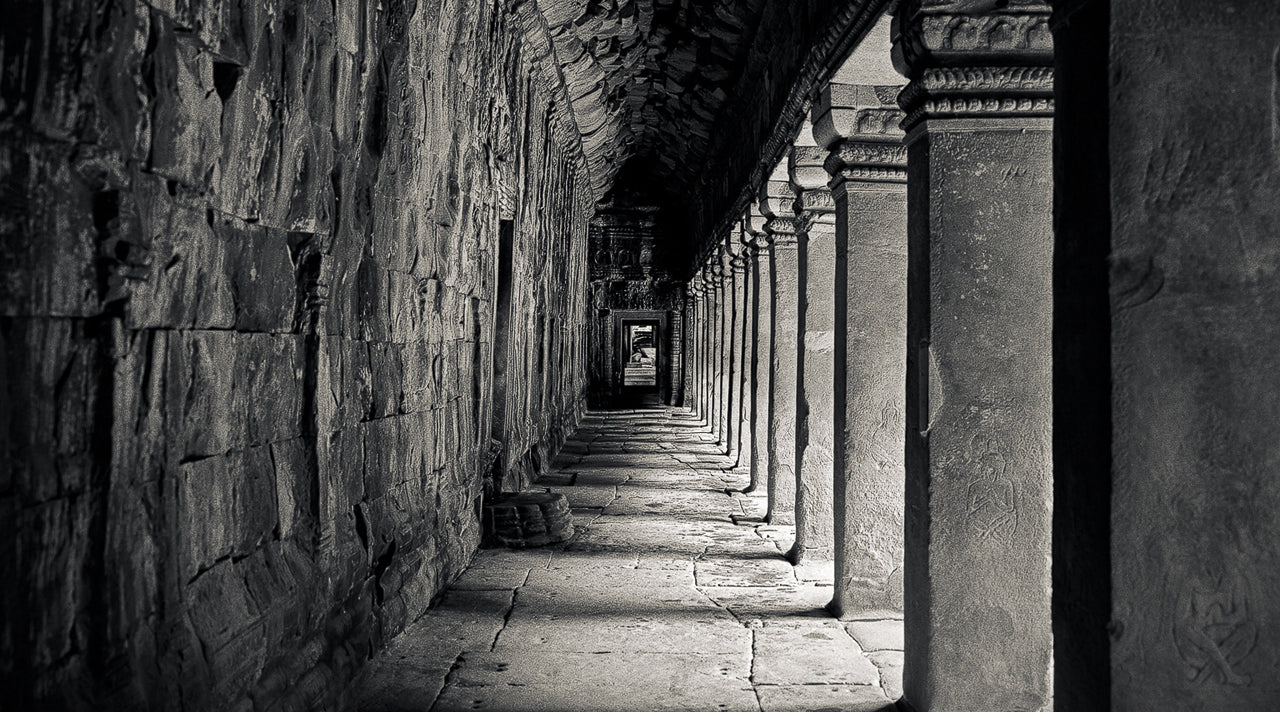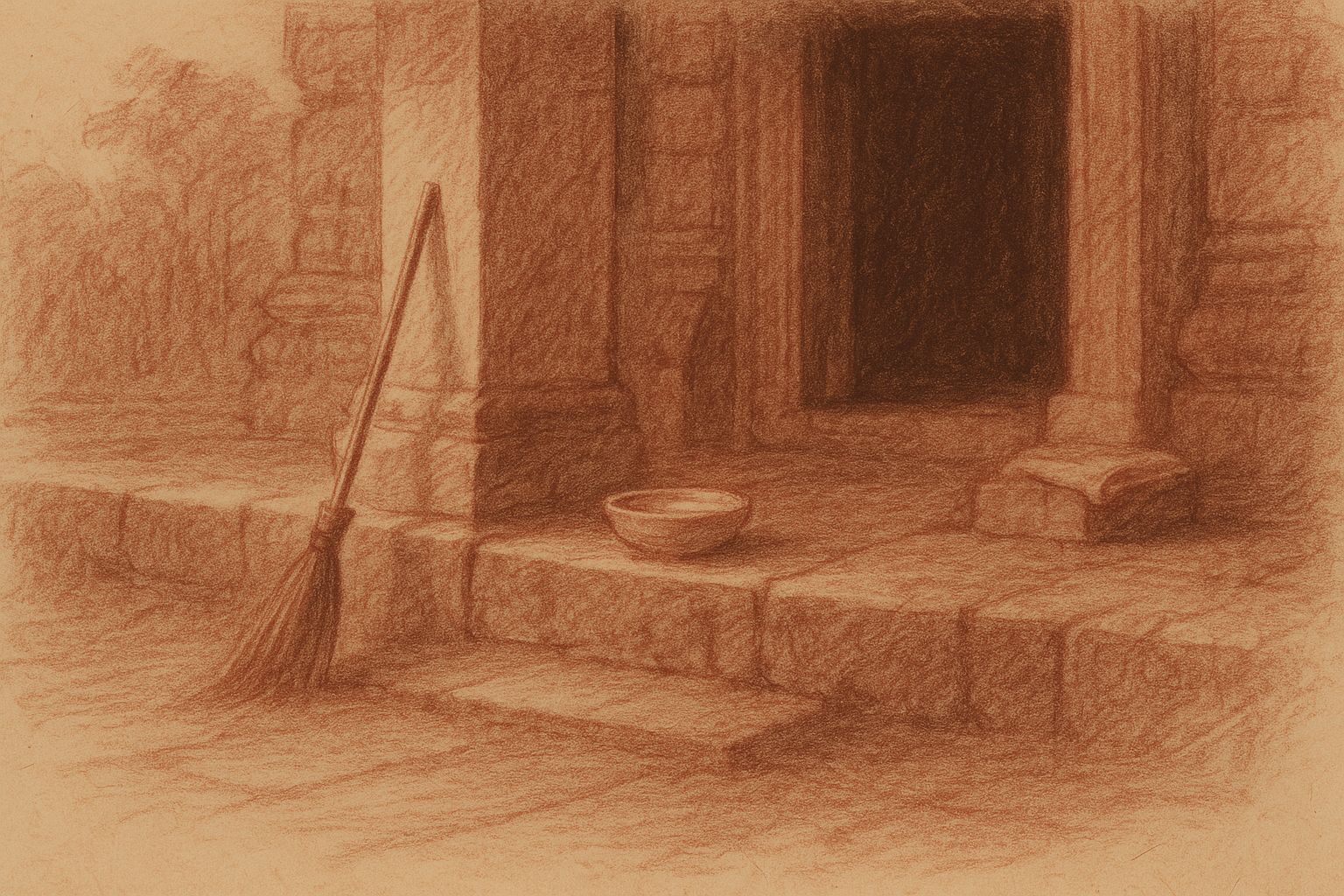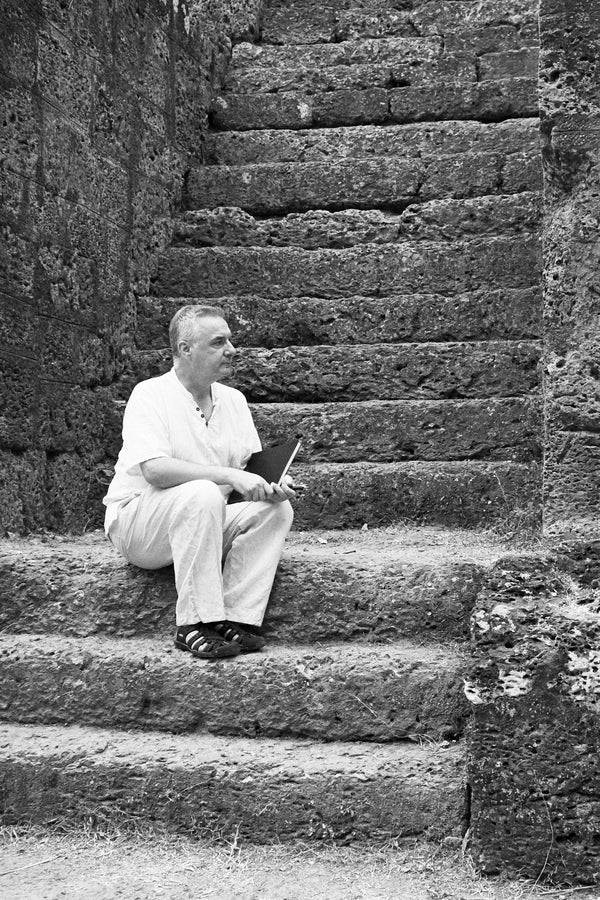Complimentary worldwide shipping on orders over $400 · No import tariffs for most countries
Complimentary worldwide shipping on orders over $400 · No import tariffs for most countries

Shadow and Stone
1 min read
Artist’s Field Journal
Shadow and Stone
Ta Prohm Temple, Angkor – Spirit of Angkor Series
Black-and-white film, hand-toned archival pigment print
The shadows came first—cool, vast, and breathing. Before even the first light of dawn crept in through the broken lintels, they were already there: waiting. They gathered like memory along the corridor walls, veiling the stone in silence, folding time into texture.
I stepped softly into the gallery as one might step into a dream half-remembered. Each pillar stood like a monk in meditation, cloaked in shadow, carved with time. Light arrived slowly—tentatively—touching the edges of stone, revealing not form, but feeling.
This is where the visible gives way to the invisible. Where shadow does not obscure, but reveals—through absence, through hush. Photographing here is not about seeing more, but seeing less… and in that less, discovering what endures.
The exposure was long, as was the stillness I kept. The lens gathered shadow like water into a vessel, and only then, when stone had revealed its inner hush, did light begin to speak.
shadow enters first
stone listens without answer—
stillness opening
Also in Library

Before the Shutter Falls
3 min read
Before the shutter falls, fear sharpens and doubt measures the cost of waiting. In the quiet hours before dawn, the act of not-yet-beginning becomes a discipline of attention. This essay reflects on patience, restraint, and the quiet mercy that arrives when outcome loosens its hold.

Those Who Keep the Way Open — On the Quiet Guardians of Angkor’s Thresholds
3 min read
Quiet gestures shape the way into Angkor — a swept stone, a refilled bowl, a hand steadying a guardian lion. This essay reflects on the unseen custodians whose daily care keeps the thresholds open, revealing how sacredness endures not through stone alone, but through those who tend its meaning.

Multiplicity and Mercy — The Face Towers of Jayavarman VII
5 min read
A new vision of kingship rises at the Bayon: serene faces turned to every horizon, shaping a world where authority is expressed as care. Moving through the terraces, one enters a field of steady, compassionate presence — a landscape where stone, light, and time teach through quiet attention.
Ta Prohm, Angkor, Cambodia — 2021
Limited Edition Archival Pigment Print
Edition
Strictly limited to 25 prints + 2 Artist’s Proofs
Medium
Hand-toned black-and-white archival pigment print on Hahnemühle Bamboo — a museum-grade fine art paper chosen for its quiet tactility and reverent depth, echoing the spirit of the temples.
Signature & Numbering
Each print is individually signed and numbered by the artist on the border (recto)
Certificate of Authenticity
Accompanies every print
Image Size
8 x 8 inches (20.3 x 20.3 cm)
Here, light does not arrive. It returns—brushing the ancient corridor of Ta Prohm Temple with a hush so soft it feels inherited. One side of the gallery glows with early breath; the other listens in shadow. The space curves slightly, gently concealing its end. Stillness gathers in the silence between each pillar.
Captured just before dawn, the eastern gallery reveals itself not through spectacle but restraint. The air hangs with moss and age. No voice disturbs it. Every line of stone, every nuance of shade, seems shaped not by hand but by time held in prayer.
The artist entered this space as one would enter a sanctuary—with breath slowed, presence quieted. Using a large format analogue camera, he waited in long exposure for the light to speak. Later, in the darkroom, chiaroscuro shaping and hand-toning gave voice to that silence—layered until feeling overtook form.
This museum-grade archival pigment print is rendered on warm, tactile Hahnemühle Bamboo paper, in a strictly limited edition of 25 + 2 Artist’s Proofs. Each is signed and numbered by the artist and accompanied by a Certificate of Authenticity and Collector’s Print Folio Statement.
To welcome this image is to open a space where stone and breath remember each other.
To walk deeper into the stillness, click here to enter the Artist’s Journal.
Previously titled ‘Gallery, Ta Prohm Temple, Angkor, Cambodia. 2021,’ this photograph has been renamed to better reflect its place in the series and its spiritual tone. The edition, provenance, and authenticity remain unchanged.
Join My Studio Journal
Receive occasional letters from my studio in Siem Reap—offering a glimpse into my creative process, early access to new fine art prints, field notes from the temples of Angkor, exhibition announcements, and reflections on beauty, impermanence, and the spirit of place.
No noise. No clutter. Just quiet inspiration, delivered gently.
Subscribe and stay connected to the unfolding story.

Join My Studio Journal
Receive occasional letters from my studio in Siem Reap—offering a glimpse into my creative process, early access to new fine art prints, field notes from the temples of Angkor, exhibition announcements, and reflections on beauty, impermanence, and the spirit of place.
No noise. No clutter. Just quiet inspiration, delivered gently.
Subscribe and stay connected to the unfolding story.

